STRATEGIES FOR ENHANCEMENT IN FOOD PRODUCTION for Class 12 BIOLOGY
INTRODUCTION
- With an ever-increasing population of the world, enhancement of food production is a major necessity. Biological principles as applied to animal husbandry and plant breeding have a major role in our efforts to increase food production. Several new techniques like embryo transfer technology and tissue culture techniques are going to play a pivotal role in further enhancing food production.
INTRODUCTION
- With an ever-increasing population of the world, enhancement of food production is a major necessity. Biological principles as applied to animal husbandry and plant breeding have a major role in our efforts to increase food production. Several new techniques like embryo transfer technology and tissue culture techniques are going to play a pivotal role in further enhancing food production.
CHAPTER WEIGHTAGE
- Iss chapter se jyada questions nhi aate. Bahut hi basic and easy going chapter hai. Generally inbreeding depression, tissue culture ya single cell proteins jaise topics short answer type questions ki form me puche jate hai.
CHAPTER WEIGHTAGE
- Iss chapter se jyada questions nhi aate. Bahut hi basic and easy going chapter hai. Generally inbreeding depression, tissue culture ya single cell proteins jaise topics short answer type questions ki form me puche jate hai.Ek- do questions hi aate hai bas
Animal Husbandry
- Beta, pashuon ka palan or unki breeding hi animal husbandry kehlata hai jahan hum pashuon ko unke meat ya other products such as milk, wool ke liye palte hai.
- Animal husbandry ki wo branch jo keval dudh dene wale animals ke sath deal kare usko hum dairying kehte hai.
- Dairying ka main goal hai, milk ki quantity and quality dono ko improve karna toh uske liye cattle ka ache se khyal rakhna, usko proper nutrition dena, saaf pani, saaf jagah rehne ke liye plus uske behavioural changes ko notice karna and disease ki management - yeah sab bahut hi jaruri hai to ensure ki milk ki quality and quantity dono hi achi ho.
- Poultry basically domesticated birds ke sath deal karti hai unke meat and eggs ke liye. Poultry me disease ke khatra jyada rehta hai and plus kuch bimariyan jaise ki bird flu entire bird livestock ko infect karke kuch hi din me bhari scale pe nuksaan kar sakti hai toh disease free environment and regular veterinarian ki visit kafi jaruri hai.
- Breed : breed animals ka wo group hai jo descent se related hai yani ki ek vansh ke and inke kafi sare characters same hote hain. For Eg : Burmese cats ki ek natural breed hai.
- Jab ek hi breed ke animals breed kare toh isko hum inbreeding kehte hai jaise ki burmese male cat and burmese female cat ke beech breeding is inbreeding.
- Jab 2 alag alag breeds me breeding ho toh usko hum crossbreeding kehte hain jaise ki Abyssinian and Burmese cat ke beech breeding se Australian mist naam ki cat jo ki ek new breed ho gayi.
- Inbreeding se homozygosity increase hoti hai jiske karan ek pureline evolve hoti hai. Pureline ka matlab hai ki jisme kisi dusre genepool ka contribution na ho lekin ek bda disadvantage inbreeding ka yeah hai continued inbreeding ke karan jo progeny banegi usme harmful/fatal genes ki accumulation hogi and unki fertility reduced hoti jayegi to an extent ki further inbred progy sterile and weak hogi. Even humans me bhi aise cases documented hai jaise ki Europe ki bahut sari royal dynasties jo yeah believe karti thi ki humari bloodline pure hai and isme kisi or ka genepool mix nhi hona chaiye, wo inbreeding jaisi practices me engage hote thy or lagbhag kafi centuries tak jiska end result yeah hota tha ki inbreeding depression ke karan ek time par aisi progeny paida hoti thi jisme bahut sare mental, physical, intellectual and sexuals problems hoti thi jiske karan wo puri dynasty hi end ho jati thi. An example of such a case is :House of Habsburg in Spain.
- Inbreeding depression se nipatne ka bahut hi saral solution hai : keval ek bar outbreeding bhi inbreeding depression ko rok sakti hai.
- Outcrossing ka matlab hai ki ek hi breed ke aise members ke beech me mating ho jinke 4-6 generation tak koi bhi common ancestor na raha ho.
- Crossbreeding ka matlab hai 2 breed ke beech me mating jaise abhi uper Australian mist (cat) ka example dekha tha.
- Interspecific hybridisation ka matlab hai 2 different but related species ke beech me mating karan jaise ki lioness and male leopard ke beech me mating leopon ko janam deti hai, zebra and donkey ki cross se zonkey bnta hai, zorse - zebra and horse ki cross se banta hai. But aisi progeny generally adulthood tak survive nhi akr pati and agar karti hai toh sterile hoti hai.
- Male ke semen ko collect karke kisi chosen female animal ke reproductive tract ke inject karna artificial insemination kehata hai.
- Kuch hormones jaise ki follicle stimulating hormone ke injection se hum superovulation induce karwa sakte hai jhan par normal per cycle ek egg ki jagah 6-8 eggs bante hai. Unko fertilise kiya jata hai and and 8-32 celled stage pe un zygotes ko surgically, mother se recover karke, ek ek zygote per surrogate mother me transplant kiya jata hai to increase herd size in a small amount of time. Issi technique ko hum multiple ovulation embryo transfer kehte hain.
- Apiculture deal karta hai beekeeping ke sath, yani ki madhumakkhiyon ka madhu/honey ke liye palan hi apiculture kehlata hai. Honeybees ki kafi species hoti hai beta, kuch jyada aggressive and kuch shant hoti hai. India me Apis indica common species hai. Bees pollinators bhi hai toh flowering season me, fields me bees ko rakhna or bhi advantageous hai kyunki wo pollination me help karengi. Ab hum jo cheez bees ko feed karate hai ya jis type ke flowers se bees nectar leti hai wo bhi honey ki quantity, quality and colour ko affect karta hai.
- Fisheries me hum fishes ko palte hai generally for their meat and sometimes eggs (eg : Salmon eggs). Fishery ka matlab hai fish, shellfish ya baki ke aquatic animals like lobsters, prawns etc. ko catch karke consumption ke liye process karna. Pisciculture keval fishes ke saath deal karta hai chahe freshwater (Catla, Rohu) ya marine fishes (Hilsa, Sardines, Pomfrets) jo bhi ho.
Animal Husbandry
- Definition : It is the agricultural practice of breeding and raising livestock.
- It deals with the care and breeding of livestock like buffaloes, cows, pigs, horses, cattle, sheep, camels, goats, poultry farming, fishery etc., that are useful to humans.
- More then 70 percent of the world livestock population is in India and China but the contribution to the world farm produce is only 25 per cent, i.e., the productivity per unit is very low.
- Dairying is the management of animals for milk and its products for human consumption.
- Dairy farm management, we deal with processes and systems that increase yield and improve quality of milk.
- Milk yield is primarily dependent on the quality of breeds in the farm. Selection of good breeds having high yielding potential (under the climatic conditions of the area), combined with resistance to diseases is very important.
- For the yield potential to be realised the cattle have to be well looked after – they have to be housed well, should have adequate water and be maintained disease free.
- The feeding of cattle should be carried out in a scientific manner – with special emphasis on the quality and quantity of fodder.
- Besides, stringent cleanliness and hygiene (both of the cattle and the handlers) are of paramount importance while milking, storage and transport of the milk and its products.
- Poultry is the class of domesticated fowl (birds) used for food or for their eggs.
- Selection of disease free and suitable breeds, proper and safe farm conditions, proper feed and water, and hygiene and health care are important components of poultry farm management.
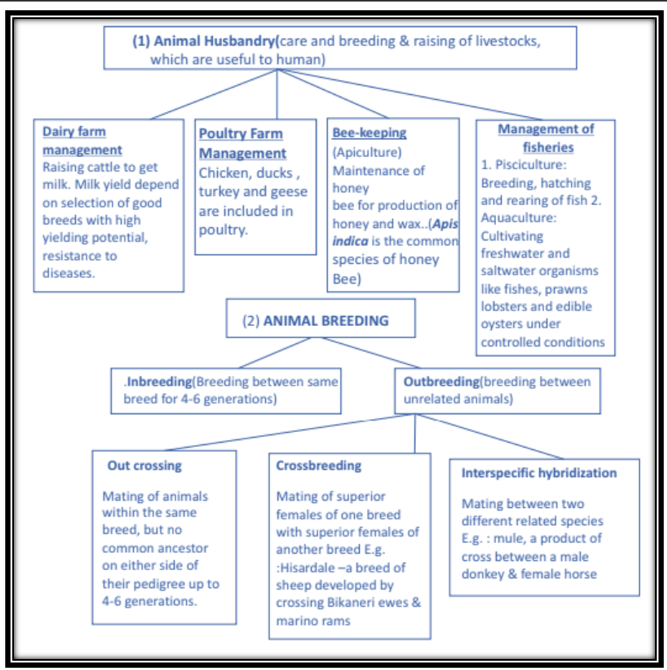
- Selection of disease free and suitable breeds, proper and safe farm conditions, proper feed and water, and hygiene and health care are important components of poultry farm management.
- Animal Breeding : aims at increasing the yield of animals and improving the desirable qualities of the produce.
- Breed : A group of animals related by descent and similar in most characters like general appearance, features, size, configuration, etc., are said to belong to a breed.
- When breeding is between animals of the same breed it is called inbreeding, while crosses between different breeds are called outbreeding.
- Inbreeding : refers to the mating of more closely related individuals within the same breed for 46 generations.
- Breeding Strategy : superior males and superior females of the same breed are identified and mated in pairs. The progeny obtained from such matings are evaluated and superior males and females among them are identified for further mating.
- A superior female, in the case of cattle, is the cow or buffalo that produces more milk per lactation. On the other hand, a superior male is the bull, which gives rise to superior progeny as compared to those of other males.

- Inbreeding increases homozygosity thus a pureline evolves.
- Disadvantages : Inbreeding exposes harmful recessive genes that are eliminated by selection. It also helps in accumulation of superior genes and elimination of less desirable genes. Continued inbreeding, especially close inbreeding, usually reduces fertility and even productivity. This is called inbreeding depression. Mating with unrelated superior animals of the same breed usually helps restore fertility and yield.

- Out-breeding : is the breeding of unrelated animals, which may be between individuals of the same breed but having no common ancestors for 4-6 generations (out-crossing) or between different breeds.

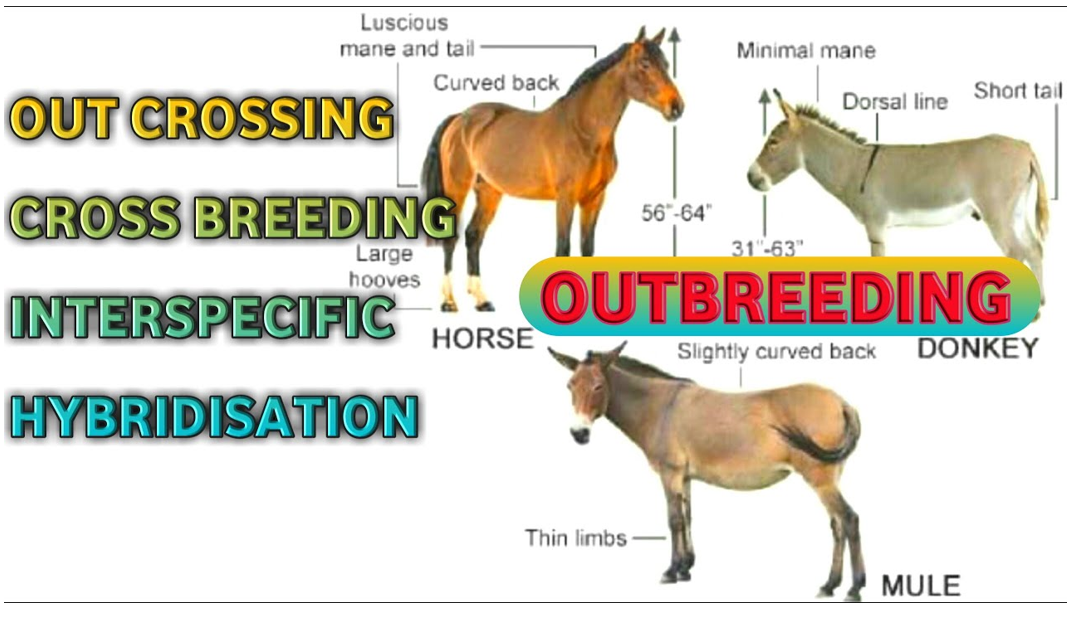
- Out-crossing: This is the practice of mating of animals within the same breed, but having no common ancestors on either side of their pedigree up to 4-6 generations. The offspring of such a mating is known as an out-cross. It is the best breeding method for animals that are below average in productivity in milk production, growth rate in beef cattle, etc. A single outcross often helps to overcome inbreeding depression.
- Cross-breeding : In this method, superior males of one breed are mated with superior females of another breed.
- Cross-breeding allows the desirable qualities of two different breeds to be combined.
- The progeny hybrid animals may themselves be used for commercial production. Alternatively, they may be subjected to some form of inbreeding and selection to develop new stable breeds that may be superior to the existing breeds.
- Many new animal breeds have been developed by this approach.
- Hissardale is a new breed of sheep developed in Punjab by crossing Bikaneri ewes and Merino rams.
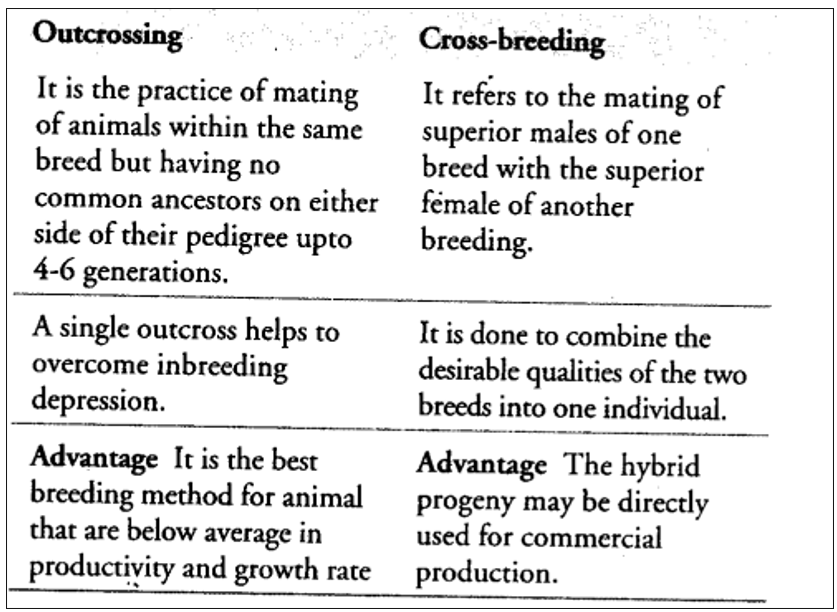
- Interspecific hybridisation: In this method, male and female animals of two different related species are mated. In some cases, the progeny may combine desirable features of both the parents, and may be of considerable economic value, e.g., the mule.
- Artificial insemination : The semen is collected from the male that is chosen as a parent and injected into the reproductive tract of the selected female by the breeder. The semen may be used immediately or can be frozen and used at a later date. It can also be transported in a frozen form to where the female is housed. In this way desirable matings are carried. Artificial insemination helps us overcome several problems of normal matings.
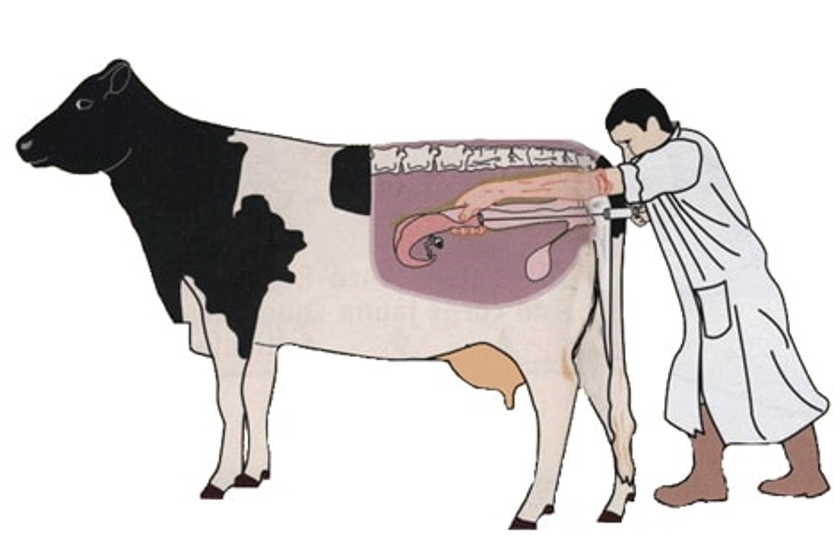
- Multiple Ovulation Embryo Transfer Technology (MOET) : a cow is administered hormones, with FSH-like activity, to induce follicular maturation and super ovulation – instead of one egg, which they normally yield per cycle, they produce 6-8 eggs.
- The animal is either mated with an elite bull or artificially inseminated.
- The fertilised eggs at 8–32 cells stages, are recovered non-surgically and transferred to surrogate mothers.

- The genetic mother is available for another round of superovulation.
- This technology has been demonstrated for cattle, sheep, rabbits, buffaloes, mares, etc.
- High milk-yielding breeds of females and high quality (lean meat with less lipid) meat-yielding bulls have been bred successfully to increase herd size in a short time.

INBREEDING
OUTBREEDING
OUTCROSSING
CROSS-BREEDING
Improving chances of successful production of hybrids : Controlled Animal Breeding

Bee-keeping (Apiculture)
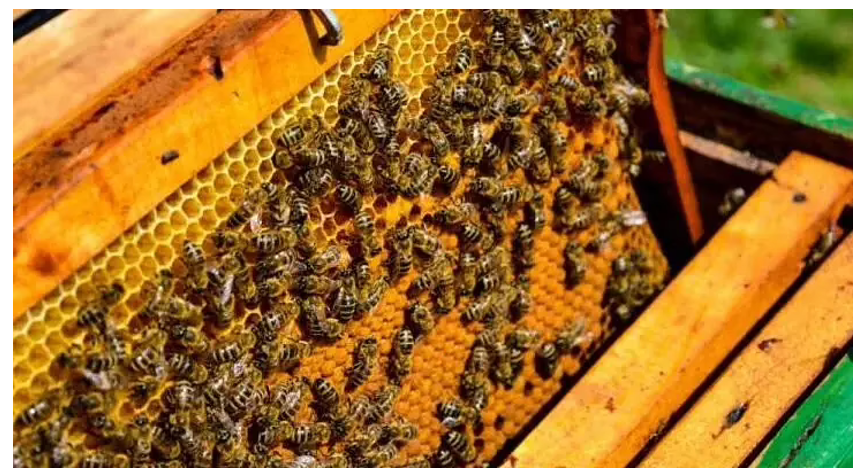

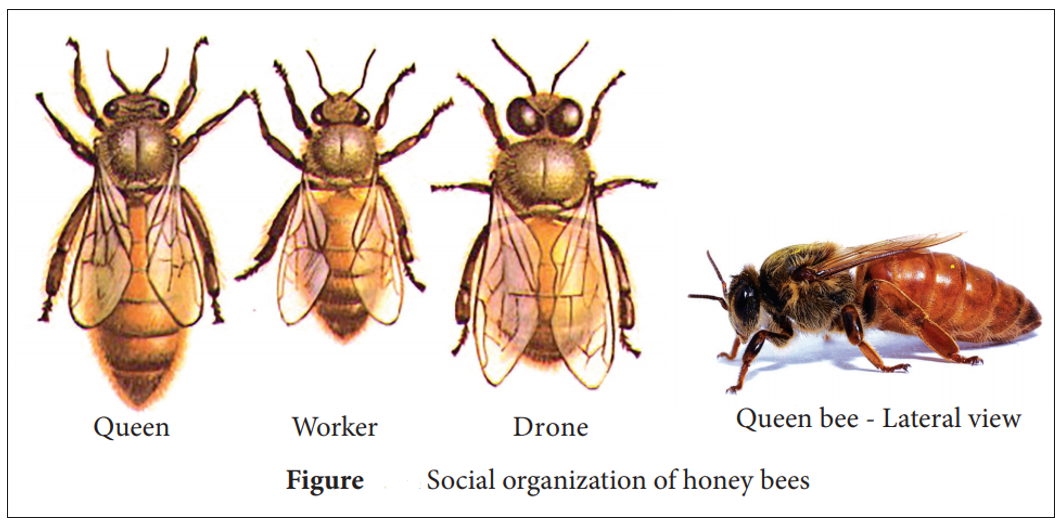
- Knowledge of the nature and habits of bees,
- Selection of suitable location for keeping the beehives,
- Catching and hiving of swarms (group of bees),
- Management of beehives during different seasons, and
- Handling and collection of honey and of beeswax.
↳ Bees are the pollinators of many of our crop species such as sunflower, Brassica, apple and pear. Keeping beehives in crop fields during the flowering period increases pollination efficiency and improves the yield–beneficial both from the point of view of crop yield and honey yield.
Fisheries
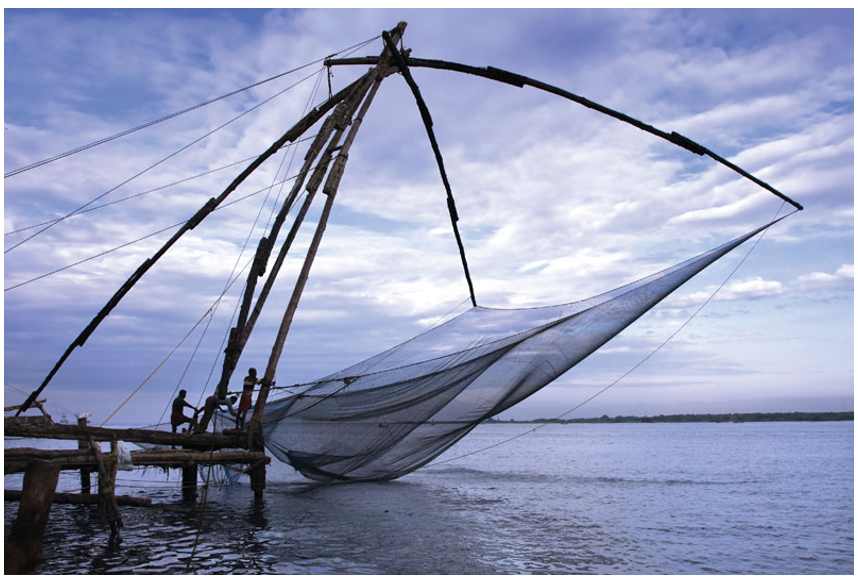

Animal Husbandry
- Definition : It is the agricultural practice of breeding and raising livestock.
- It deals with the care and breeding of livestock like buffaloes, cows, pigs, horses, cattle, sheep, camels, goats, poultry farming, fishery etc., that are useful to humans.
- More then 70 percent of the world livestock population is in India and China but the contribution to the world farm produce is only 25 per cent, i.e., the productivity per unit is very low.
- Dairying is the management of animals for milk and its products for human consumption.
- Dairy farm management, we deal with processes and systems that increase yield and improve quality of milk.
- Milk yield is primarily dependent on the quality of breeds in the farm. Selection of good breeds having high yielding potential (under the climatic conditions of the area), combined with resistance to diseases is very important.
- For the yield potential to be realised the cattle have to be well looked after – they have to be housed well, should have adequate water and be maintained disease free.
- The feeding of cattle should be carried out in a scientific manner – with special emphasis on the quality and quantity of fodder.
- Besides, stringent cleanliness and hygiene (both of the cattle and the handlers) are of paramount importance while milking, storage and transport of the milk and its products.
- Poultry is the class of domesticated fowl (birds) used for food or for their eggs.
- Selection of disease free and suitable breeds, proper and safe farm conditions, proper feed and water, and hygiene and health care are important components of poultry farm management.

- Selection of disease free and suitable breeds, proper and safe farm conditions, proper feed and water, and hygiene and health care are important components of poultry farm management.
- Animal Breeding : aims at increasing the yield of animals and improving the desirable qualities of the produce.
- Breed : A group of animals related by descent and similar in most characters like general appearance, features, size, configuration, etc., are said to belong to a breed.
- When breeding is between animals of the same breed it is called inbreeding, while crosses between different breeds are called outbreeding.
- Inbreeding : refers to the mating of more closely related individuals within the same breed for 46 generations.
- Breeding Strategy : superior males and superior females of the same breed are identified and mated in pairs. The progeny obtained from such matings are evaluated and superior males and females among them are identified for further mating.
- A superior female, in the case of cattle, is the cow or buffalo that produces more milk per lactation. On the other hand, a superior male is the bull, which gives rise to superior progeny as compared to those of other males.

- Inbreeding increases homozygosity thus a pureline evolves.
- Disadvantages : Inbreeding exposes harmful recessive genes that are eliminated by selection. It also helps in accumulation of superior genes and elimination of less desirable genes. Continued inbreeding, especially close inbreeding, usually reduces fertility and even productivity. This is called inbreeding depression. Mating with unrelated superior animals of the same breed usually helps restore fertility and yield.

- Out-breeding : is the breeding of unrelated animals, which may be between individuals of the same breed but having no common ancestors for 4-6 generations (out-crossing) or between different breeds.


- Out-crossing: This is the practice of mating of animals within the same breed, but having no common ancestors on either side of their pedigree up to 4-6 generations. The offspring of such a mating is known as an out-cross. It is the best breeding method for animals that are below average in productivity in milk production, growth rate in beef cattle, etc. A single outcross often helps to overcome inbreeding depression.
- Cross-breeding : In this method, superior males of one breed are mated with superior females of another breed.
- Cross-breeding allows the desirable qualities of two different breeds to be combined.
- The progeny hybrid animals may themselves be used for commercial production. Alternatively, they may be subjected to some form of inbreeding and selection to develop new stable breeds that may be superior to the existing breeds.
- Many new animal breeds have been developed by this approach.
- Hissardale is a new breed of sheep developed in Punjab by crossing Bikaneri ewes and Merino rams.

- Interspecific hybridisation: In this method, male and female animals of two different related species are mated. In some cases, the progeny may combine desirable features of both the parents, and may be of considerable economic value, e.g., the mule.
- Artificial insemination : The semen is collected from the male that is chosen as a parent and injected into the reproductive tract of the selected female by the breeder. The semen may be used immediately or can be frozen and used at a later date. It can also be transported in a frozen form to where the female is housed. In this way desirable matings are carried. Artificial insemination helps us overcome several problems of normal matings.

- Multiple Ovulation Embryo Transfer Technology (MOET) : a cow is administered hormones, with FSH-like activity, to induce follicular maturation and super ovulation – instead of one egg, which they normally yield per cycle, they produce 6-8 eggs.
- The animal is either mated with an elite bull or artificially inseminated.
- The fertilised eggs at 8–32 cells stages, are recovered non-surgically and transferred to surrogate mothers.

- The genetic mother is available for another round of superovulation.
- This technology has been demonstrated for cattle, sheep, rabbits, buffaloes, mares, etc.
- High milk-yielding breeds of females and high quality (lean meat with less lipid) meat-yielding bulls have been bred successfully to increase herd size in a short time.

INBREEDING
OUTBREEDING
OUTCROSSING
CROSS-BREEDING
Improving chances of successful production of hybrids : Controlled Animal Breeding

Bee-keeping (Apiculture)



- Knowledge of the nature and habits of bees,
- Selection of suitable location for keeping the beehives,
- Catching and hiving of swarms (group of bees),
- Management of beehives during different seasons, and
- Handling and collection of honey and of beeswax.
↳ Bees are the pollinators of many of our crop species such as sunflower, Brassica, apple and pear. Keeping beehives in crop fields during the flowering period increases pollination efficiency and improves the yield–beneficial both from the point of view of crop yield and honey yield.
Fisheries


Plant Breeding
- Plant breeding is the purposeful manipulation (=breeding) of plant species in order to create desired genotypes and phenotypes for specific purposes like disease resistant, resistant to abiotic stress, increasing the yield etc. because traditional farming can only yield a limited biomass.
- Classical plant breeding involves crossing or hybridisation of pure lines, followed by artificial selection to produce plants with desirable traits of higher yield, nutrition and resistance to diseases.
- The main steps in breeding a new genetic variety of a crop are –
- Collection of variability: Genetic variability is the root of any breeding programme. In many crops pre-existing genetic variability is available from wild relatives of the crop. Collection and preservation of all the different wild varieties, species and relatives of the cultivated species (followed by their evaluation for their characteristics) is a pre-requisite for effective exploitation of natural genes available in the populations. The entire collection (of plants/seeds) having all the diverse alleles for all genes in a given crop is called germplasm collection.
- Evaluation and selection of parents: The germplasm is evaluated so as to identify plants with desirable combination of characters. The selected plants are multiplied and used in the process of hybridisation. Purelines are created wherever desirable and possible.
- Cross hybridisation among the selected parents: The desired characters have very often to be combined from two different plants (parents), for example high protein quality of one parent may need to be combined with disease resistance from another parent. This is possible by cross hybridising the two parents to produce hybrids that genetically combine the desired characters in one plant. This is a very time-consuming and tedious process since the pollen grains from the desirable plant chosen as male parent have to be collected and placed on the stigma of the flowers selected as female parent. Also, it is not necessary that the hybrids do combine the desirable characters; usually only one in few hundred to a thousand crosses shows the desirable combination.
- Selection and testing of superior recombinants: This step consists of selecting, among the progeny of the hybrids, those plants that have the desired character combination. The selection process is crucial to the success of the breeding objective and requires careful scientific evaluation of the progeny. This step yields plants that are superior to both of the parents (very often more than one superior progeny plant may become available). These are self-pollinated for several generations till they reach a state of uniformity (homozygosity), so that the characters will not segregate in the progeny.
- Testing, release and commercialisation of new cultivars: The newly selected lines are evaluated for their yield and other agronomic traits of quality, disease resistance, etc. This evaluation is done by growing these in the research fields and recording their performance under ideal fertiliser application, irrigation, and other crop management practices. The evaluation in research fields is followed by testing the materials in farmers’ fields, for at least three growing seasons at several locations in the country, representing all the agroclimatic zones where the crop is usually grown. The material is evaluated in comparison to the best available local crop cultivar – a check or reference cultivar.

- Agriculture accounts for approximately 33 per cent of India’s GDP and employs nearly 62 per cent of the population.
- The development of several high yielding varieties of wheat and rice in the mid-1960s, as a result of various plant breeding techniques led to dramatic increase in food production in our country. This phase is often referred to as the Green Revolution.
- Wheat and Rice : During the period 1960 to 2000, wheat and rice production increased to several tonnes due to the development of semi-dwarf varieties of wheat and rice by Norman E. Borlaug at International Centre for Wheat and Maize Improvement in Mexico.
- High yielding and disease resistant wheat varieties developed during 1963 :Sonalika and Kalyan Sona
- Semi-dwarf rice varieties were derived from IR-8, (developed at International Rice Research Institute (IRRI), Philippines) and Taichung Native-1 (from Taiwan).
- Better-yielding semidwarf varieties Jaya and Ratna were developed in India.
- Sugar cane : Saccharum barberi was originally grown in north India, but had poor sugar content and yield. Tropical canes grown in south India Saccharum officinarum had thicker stems and higher sugar content but did not grow well in north India. These two species were successfully crossed to get sugar cane varieties combining the desirable qualities of high yield, thick stems, high sugar and ability to grow in the sugar cane areas of north India.
- Millets: Hybrid maize, jowar and bajra have been successfully developed in India. Hybrid breeding have led to the development of several high yielding varieties resistant to water stress.
- Resistance of the host plant is the ability to prevent the pathogen from causing disease and is determined by the genetic constitution of the host plant.
- Advantages : helps reduce the dependence on use of fungicides and bactericides, better yield, less post harvest loss, etc.
- Some of the diseases caused by fungi are rusts, e.g., brown rust of wheat, red rot of sugarcane and late blight of potato; by bacteria– black rot of crucifers; and by viruses – tobacco mosaic, turnip mosaic, etc.
- Methods of breeding for disease resistance : Breeding is carried out by the conventional breeding techniques (described earlier) or by mutation breeding.
- The various sequential steps are : screening germplasm for resistance sources, hybridisation of selected parents, selection and evaluation of the hybrids and testing and release of new varieties..
- Crop varieties resistance to fungi, bacteria are shown below :

- Limitation of conventional breeding : Conventional breeding is often constrained by the availability of a limited number of disease resistance genes that are present and identified in various crop varieties or wild relatives.
↳ Solution : Mutations - Mutation is the process by which genetic variations are created through changes in the base sequence within genes resulting in the creation of a new character or trait not found in the parental type.
- How to induce mutations : It is possible to induce mutations artificially through use of chemicals or radiations (like gamma radiations), and selecting and using the plants that have the desirable character as a source in breeding – this process is called mutation breeding. In mung bean, resistance to yellow mosaic virus and powdery mildew were induced by mutations.
- Resistance to yellow mosaic virus in bhindi (Abelmoschus esculentus) was transferred from a wild species and resulted in a new variety of A. esculentus called Parbhani kranti.
- Insect and Pest Infestation :Another major cause for large scale destruction of crop plant and crop produce.
- Natural Resistance :
- Hairy leaves in several plants are associated with resistance to insect pests, e.g, resistance to jassids in cotton and cereal leaf beetle in wheat. In wheat, solid stems lead to non-preference by the stem sawfly and smooth leaved and nectar-less cotton varieties do not attract bollworms. High aspartic acid, low nitrogen and sugar content in maize leads to resistance to maize stem borers.
- Some crop varieties bred by hybridisation and selection, for insect pest resistance are shown below :
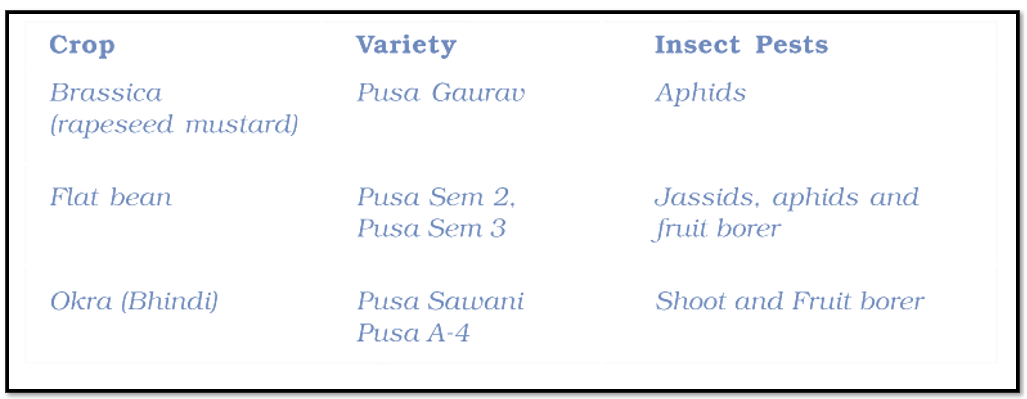
- Three billion people – suffer from micronutrients, protein and vitamin deficiencies or ‘hidden hunger’ because they cannot afford to buy enough fruits, vegetables, legumes, fish and meat.
- Biofortification – breeding crops with higher levels of vitamins and minerals, or higher protein and healthier fats – is the most practical means to improve public health.
- Breeding for improved nutritional quality is undertaken with the objectives of improving :
- Protein content and quality;
- Oil content and quality;
- Vitamin content; and
- Micronutrient and mineral content.
- Wheat variety, Atlas 66 has a high protein content.
- The Indian Agricultural Research Institute, New Delhi has also released several vegetable crops that are rich in vitamins and minerals, e.g., vitamin A enriched carrots, spinach, pumpkin; vitamin C enriched bitter gourd, bathua, mustard, tomato; iron and calcium enriched spinach and bathua; and protein enriched beans – broad, lablab, French and garden peas.
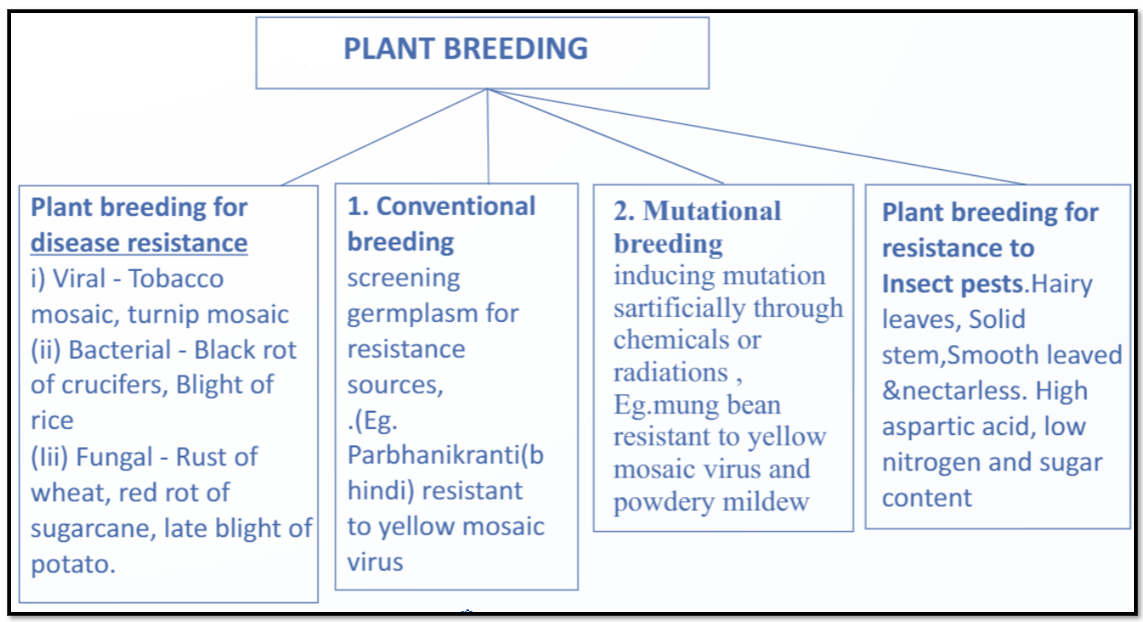
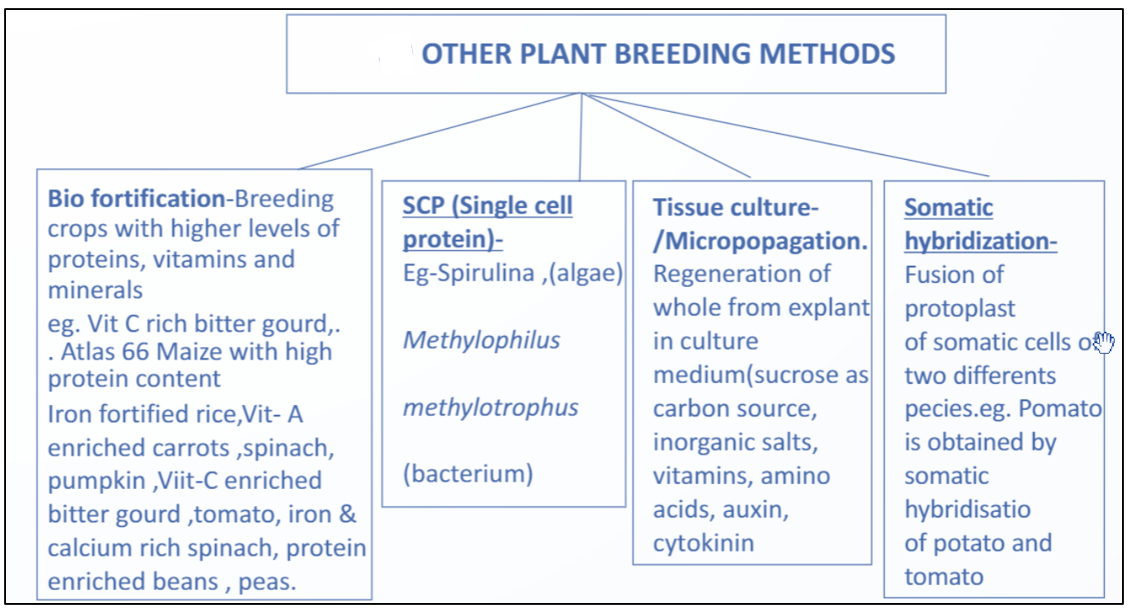
Plant Breeding for Disease Resistance :
Plant Breeding for Developing Resistance to Insect Pests :
Plant Breeding for Improved Food Quality :
Plant Breeding
- Jaan bujh kar different plants ki apas me breeding karwana taki hume progeny me ek desired genotype and/or phenotype mile, ussi ko plant breeding kaha gya hai.
- Sabse pehla step hai ; collection of variability. Yani ki aap aise plants ko select karoge jinme desired trait ho jaise ki ek plant ka high yield hai and kisi me disease resistance hai toh aise karke jo jo desirable characters hai, un characters ko possess karne wale plants ko collect kiya jata hai.
- Fir hum agli step me parents ko evaluate karke select karenge ki bhyii yeah yeah plants apparent serve karenge yani ki pehli step me jitne plants collect kiye thy unme se bet candidates ko hum aage breed karwane ke liye select karenge.
- Next step aati hai selected parents me cross hybridisation. Yeah process jitni aasan lag rhi hai actual me kafi mushkil or tedious hai. Toh jo progeny paida hogi, next step me hum un progeny me se superior individuals ko choose karenge. Agar wo edible crop plant hai toh un superior recombinants ko lab me safety test karke general market me release kiya jata hai.
- E. Borlaug ne 1960-2000 me wheat and rice ki semi-dwarf varieties bnaie thi jinki yield jyada tha.
- Sonalika & kalyan Sona : yeah wheat ki high yield wali disease resistant varieties hai jo 1963 me banaie gyi thi.
- India me banie gyi rice ki semi-dwarf varieties hai : Jaya and Ratna.
- North India me ugane wale sugarcane ka yield kafi poor hota tha lekin South me ugane wale sugarcane ka yield acha tha but wo North India me grow nhi karta tha toh scientists ne lab me in dono varieties ko cross breed karwa kar sugarcane ki ek new variety bna di jo North India me ache se grow karta tha and uska yield bhi bdia tha.
- Disease resistant plant hum isiliye paida karte hai taki post harvest loss kam ho sake, fungicides and bactericides jaise medicines, and chemical fertilisers par humari crop kam ya na ke brabar nirbhar kare or in chemical ki bio system me biomagnification bhi na ho paye. Common fungal disease are : brown rust of wheat, red rot of sugarcane and late blight of potato
- Conventional breeding ki major limitation yeah hai ki nature me bahut ki kam disease resistant genes hai jinko hum utilise kar sakte hai apne plant breeding programmes me toh iska ek solution hai : mutations. Mutation karwana ek aisa procedure hai jisme hum kisi cell ke genetic material ko alter karte hain. Toh genes ki sequence me halke fulke changes karke we can create new varieties although hamesha itna straightforward nhi hota but we have done some progress in this context too.
- Disease resistant Bhindi jiska common name parbhani kranti hai wo yellow mosaic virus se hone wali bimari ke liye resistant/immune hai.
- Aise hi hum field me insects ke dwara hone wale crop loss ko kam karne ke liye insect & pest resistant plant varieties develop kar rhe hai. Kuch plants me natural tareeko se yeah resistant milti hai jaise ki bahut se plants ki leaves par chote chote hair like structures hote hai jo unko insect attack se bachate hai. Iska common sa example hai : cotton is resistant to jassids, nectar less cotton ki varities bollworms se safe hai, maize me high aspartic acid content and low nitrogen content maize plant ko maize stem borers se bachata hai.
- Aise hi hum plants ko food quality improve karne ke liye breed karwa sakte hai jiso biofortification kaha jata hai jaise ki Atlas 66 wheat variety me protein content usual se jyada hota hai, vitamin A enriched carrots, spinach and pumpkin develop kiye gye hain, aise hi iron and calcium enriched spinach and bathua bhi develop kia gya hai.
Important Points :
Single Cell Protein (SCP)
- Single cells, better known as unicellular organisms which are rich in protein content and are safe for human consumption are generally used as protein supplements.
- It takes 3-10 Kg of grain to produce 1 Kg of meat by animal farming.
- Microbes like Spirulina can be grown easily on materials like waste water from potato processing plants (containing starch), straw, molasses, animal manure and even sewage, to produce large quantities and can serve as food rich in protein, minerals, fats, carbohydrate and vitamins.
- A 250 Kg cow produces 200 g of protein per day. In the same period, 250g of a micro-organism like Methylophilus methylotrophus, because of its high rate of biomass production and growth, can be expected to produce 25 tonnes of protein.
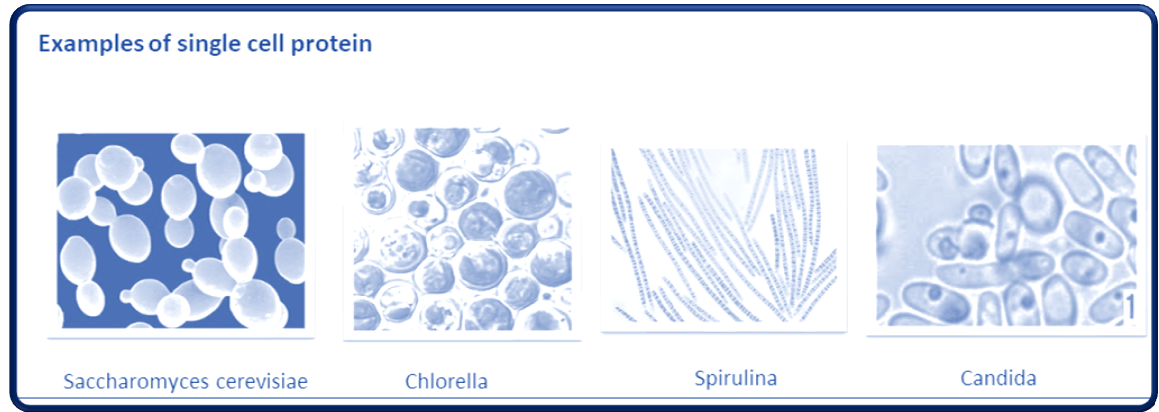
Plant Breeding
- Plant breeding is the purposeful manipulation (=breeding) of plant species in order to create desired genotypes and phenotypes for specific purposes like disease resistant, resistant to abiotic stress, increasing the yield etc. because traditional farming can only yield a limited biomass.
- Classical plant breeding involves crossing or hybridisation of pure lines, followed by artificial selection to produce plants with desirable traits of higher yield, nutrition and resistance to diseases.
- The main steps in breeding a new genetic variety of a crop are –
- Collection of variability: Genetic variability is the root of any breeding programme. In many crops pre-existing genetic variability is available from wild relatives of the crop. Collection and preservation of all the different wild varieties, species and relatives of the cultivated species (followed by their evaluation for their characteristics) is a pre-requisite for effective exploitation of natural genes available in the populations. The entire collection (of plants/seeds) having all the diverse alleles for all genes in a given crop is called germplasm collection.
- Evaluation and selection of parents: The germplasm is evaluated so as to identify plants with desirable combination of characters. The selected plants are multiplied and used in the process of hybridisation. Purelines are created wherever desirable and possible.
- Cross hybridisation among the selected parents: The desired characters have very often to be combined from two different plants (parents), for example high protein quality of one parent may need to be combined with disease resistance from another parent. This is possible by cross hybridising the two parents to produce hybrids that genetically combine the desired characters in one plant. This is a very time-consuming and tedious process since the pollen grains from the desirable plant chosen as male parent have to be collected and placed on the stigma of the flowers selected as female parent. Also, it is not necessary that the hybrids do combine the desirable characters; usually only one in few hundred to a thousand crosses shows the desirable combination.
- Selection and testing of superior recombinants: This step consists of selecting, among the progeny of the hybrids, those plants that have the desired character combination. The selection process is crucial to the success of the breeding objective and requires careful scientific evaluation of the progeny. This step yields plants that are superior to both of the parents (very often more than one superior progeny plant may become available). These are self-pollinated for several generations till they reach a state of uniformity (homozygosity), so that the characters will not segregate in the progeny.
- Testing, release and commercialisation of new cultivars: The newly selected lines are evaluated for their yield and other agronomic traits of quality, disease resistance, etc. This evaluation is done by growing these in the research fields and recording their performance under ideal fertiliser application, irrigation, and other crop management practices. The evaluation in research fields is followed by testing the materials in farmers’ fields, for at least three growing seasons at several locations in the country, representing all the agroclimatic zones where the crop is usually grown. The material is evaluated in comparison to the best available local crop cultivar – a check or reference cultivar.

- Agriculture accounts for approximately 33 per cent of India’s GDP and employs nearly 62 per cent of the population.
- The development of several high yielding varieties of wheat and rice in the mid-1960s, as a result of various plant breeding techniques led to dramatic increase in food production in our country. This phase is often referred to as the Green Revolution.
- Wheat and Rice : During the period 1960 to 2000, wheat and rice production increased to several tonnes due to the development of semi-dwarf varieties of wheat and rice by Norman E. Borlaug at International Centre for Wheat and Maize Improvement in Mexico.
- High yielding and disease resistant wheat varieties developed during 1963 :Sonalika and Kalyan Sona
- Semi-dwarf rice varieties were derived from IR-8, (developed at International Rice Research Institute (IRRI), Philippines) and Taichung Native-1 (from Taiwan).
- Better-yielding semidwarf varieties Jaya and Ratna were developed in India.
- Sugar cane : Saccharum barberi was originally grown in north India, but had poor sugar content and yield. Tropical canes grown in south India Saccharum officinarum had thicker stems and higher sugar content but did not grow well in north India. These two species were successfully crossed to get sugar cane varieties combining the desirable qualities of high yield, thick stems, high sugar and ability to grow in the sugar cane areas of north India.
- Millets: Hybrid maize, jowar and bajra have been successfully developed in India. Hybrid breeding have led to the development of several high yielding varieties resistant to water stress.
- Resistance of the host plant is the ability to prevent the pathogen from causing disease and is determined by the genetic constitution of the host plant.
- Advantages : helps reduce the dependence on use of fungicides and bactericides, better yield, less post harvest loss, etc.
- Some of the diseases caused by fungi are rusts, e.g., brown rust of wheat, red rot of sugarcane and late blight of potato; by bacteria– black rot of crucifers; and by viruses – tobacco mosaic, turnip mosaic, etc.
- Methods of breeding for disease resistance : Breeding is carried out by the conventional breeding techniques (described earlier) or by mutation breeding.
- The various sequential steps are : screening germplasm for resistance sources, hybridisation of selected parents, selection and evaluation of the hybrids and testing and release of new varieties..
- Crop varieties resistance to fungi, bacteria are shown below :

- Limitation of conventional breeding : Conventional breeding is often constrained by the availability of a limited number of disease resistance genes that are present and identified in various crop varieties or wild relatives.
↳ Solution : Mutations - Mutation is the process by which genetic variations are created through changes in the base sequence within genes resulting in the creation of a new character or trait not found in the parental type.
- How to induce mutations : It is possible to induce mutations artificially through use of chemicals or radiations (like gamma radiations), and selecting and using the plants that have the desirable character as a source in breeding – this process is called mutation breeding. In mung bean, resistance to yellow mosaic virus and powdery mildew were induced by mutations.
- Resistance to yellow mosaic virus in bhindi (Abelmoschus esculentus) was transferred from a wild species and resulted in a new variety of A. esculentus called Parbhani kranti.
- Insect and Pest Infestation :Another major cause for large scale destruction of crop plant and crop produce.
- Natural Resistance :
- Hairy leaves in several plants are associated with resistance to insect pests, e.g, resistance to jassids in cotton and cereal leaf beetle in wheat. In wheat, solid stems lead to non-preference by the stem sawfly and smooth leaved and nectar-less cotton varieties do not attract bollworms. High aspartic acid, low nitrogen and sugar content in maize leads to resistance to maize stem borers.
- Some crop varieties bred by hybridisation and selection, for insect pest resistance are shown below :

- Three billion people – suffer from micronutrients, protein and vitamin deficiencies or ‘hidden hunger’ because they cannot afford to buy enough fruits, vegetables, legumes, fish and meat.
- Biofortification – breeding crops with higher levels of vitamins and minerals, or higher protein and healthier fats – is the most practical means to improve public health.
- Breeding for improved nutritional quality is undertaken with the objectives of improving :
- Protein content and quality;
- Oil content and quality;
- Vitamin content; and
- Micronutrient and mineral content.
- Wheat variety, Atlas 66 has a high protein content.
- The Indian Agricultural Research Institute, New Delhi has also released several vegetable crops that are rich in vitamins and minerals, e.g., vitamin A enriched carrots, spinach, pumpkin; vitamin C enriched bitter gourd, bathua, mustard, tomato; iron and calcium enriched spinach and bathua; and protein enriched beans – broad, lablab, French and garden peas.


Plant Breeding for Disease Resistance :
Plant Breeding for Developing Resistance to Insect Pests :
Plant Breeding for Improved Food Quality :
Tissue Culture
- It simply means culturing tissue in nutritional media, in vitro.
- Whole plants could be regenerated from explants, i.e., any part of a plant taken out and grown in a test tube, under sterile conditions in special nutrient media.
- Capacity to generate a whole plant from any cell/explant is called totipotency.
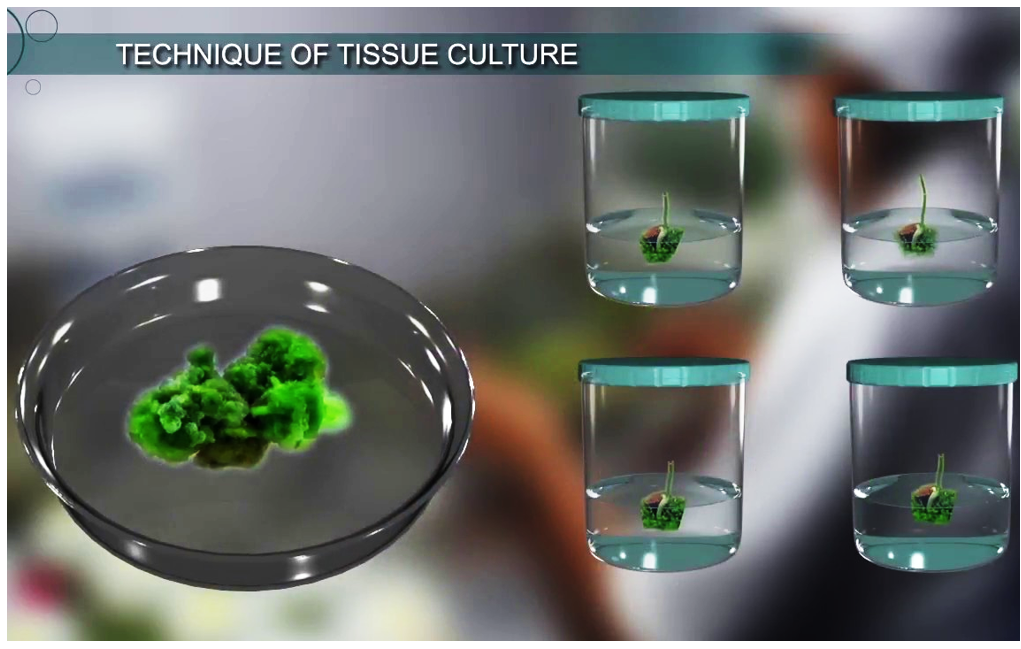
- Method of producing thousands of plants through tissue culture is called micro-propagation
- Each of these plants will be genetically identical to the original plant from which they were grown, i.e., they are somaclones.
- If the plant is infected with a virus, the meristem (apical and axillary) is free of virus. Hence, we can remove the meristem and grow it in vitro to obtain virus-free plants.
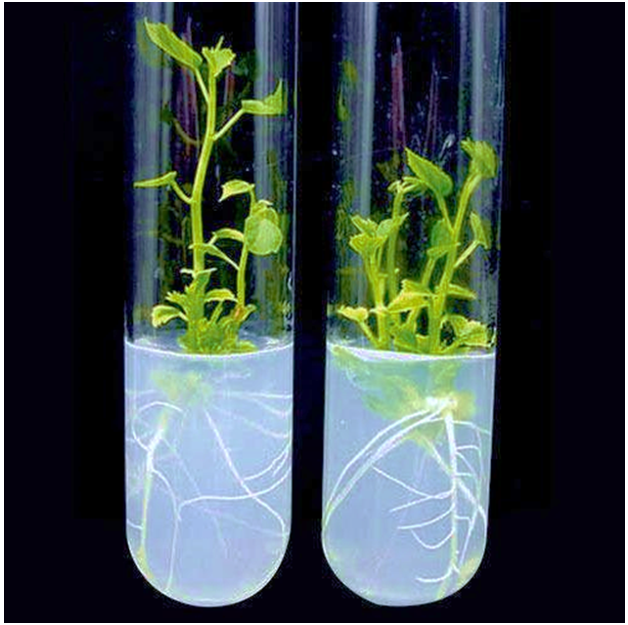
- Isolated protoplasts (after digesting their cell walls) from two different varieties of plants – each having a desirable character – can be fused to get hybrid protoplasts, which can be further grown to form a new plant. These hybrids are called somatic hybrids while the process is called somatic hybridisation. Eg : Pomato
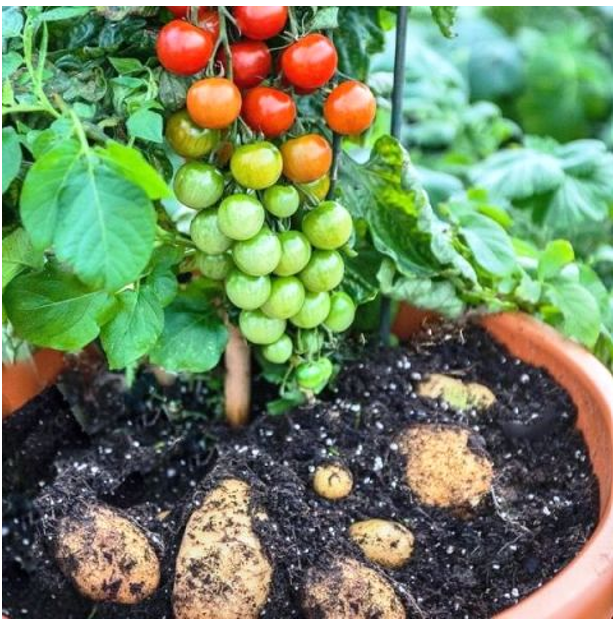
Fig : Pomato
Single Cell Protein (SCP)
- Beta, unicellular organisms ke protein rich biomass ko hi SCP bola jata hai jinko hum as a food source use kar sake. Aajkal halanki multicellular organisms ko bhi iss definition me include karte hai.
- Most common SCP : Candida utilis (single celled yeast) and Fusarium graminearum (a filamentous fungus).
- Sabse earlier SCP ka source hai : Spirulina jo ki ek cyanobacterium hai.. Even mushroom bhi jo ki ek kafi common food source hai aajkal wo bhi originally ek fungus hai.
- Hume in microorganisms pe depend ya inki taraf mudna 2 main karano se pda. Ek toh inki protein biomass availability bahut jyada hai jo ki lagataar grow ka rhi human population ke liye plant and animal food source se proper adequate food ka mil pana thoda mushkil hai. Dusra yeah ki SCP are high in protein and poor in fats jo ki ek ideal human diet hai (lekin yaad rakhna ki healthy fats human diet ke liye bahut hi jyada zaruri hai), of course along with vitamins and minerals. Ek rough estimate ke taur pe human diet me macromolecules me 50% carbohydrates, 40% tak proteins and 9%-10% fats chahiye hota hai.
- 250g Methylophilus methylotrophus bacteria ek din me 250 tonn protein produce kar sakta hai jabki ek din ek 250kg ki cow keval 200-300g protein produce kar pati hai.
Summary
- Animal husbandry is the practice of taking care and breeding domestic animals by applying scientific principles. The ever-increasing demand of food from animals and animal products both in terms of quality and quantity has been met by good animal husbandry practices. These practices include (i) management of farm and farm animals, and (ii) animal breeding. In view of the high nutritive value of honey and its medicinal importance, there has been a remarkable growth in the practice of bee-keeping or apiculture. Fishery is another flourishing industry meeting the ever-increasing demand for fish, fish products and other aquatic foods.
Plant breeding may be used to create varieties, which are resistant to pathogens and to insect pests. This increases the yield of the food. This method has also been used to increase the protein content of the plant foods and thereby enhance the quality of food. In India, several varieties of different crop plants have been produced. All these measures enhance the production of food. Techniques of tissue culture and somatic hybridisation offer vast potential for manipulation of plants in vitro to produce new varieties.
Single Cell Protein (SCP)
- Single cells, better known as unicellular organisms which are rich in protein content and are safe for human consumption are generally used as protein supplements.
- It takes 3-10 Kg of grain to produce 1 Kg of meat by animal farming.
- Microbes like Spirulina can be grown easily on materials like waste water from potato processing plants (containing starch), straw, molasses, animal manure and even sewage, to produce large quantities and can serve as food rich in protein, minerals, fats, carbohydrate and vitamins.
- A 250 Kg cow produces 200 g of protein per day. In the same period, 250g of a micro-organism like Methylophilus methylotrophus, because of its high rate of biomass production and growth, can be expected to produce 25 tonnes of protein.

Tissue Culture
- In vitro me cells and tissues ko grow karna & maintain karna hi tissue culture kehlata hai chahe wo animal cells ho ya plant cells.
- Ek somatic cell ki wo ability jiske karan wo full fledged plant bna de wo totipotency kehlati hai and uss cell ko hum totipotent kehte hai.
- Soil me grow kar rahe plant ka jo hissa hum excise/cut karke lab me tissue culture ke liye use karenge wo explant kehlata hai and generally hum meristematic cells lete hai kyunki wo highly dividing cell hai toh aise cells me bacteria ya virus ke infection ka khatra kafi kam hai jiske karan hum ek diseased plant se bhi healthy tissue culture lekr usko bhi use kar sakte hai.
- Unorganised, irregular cell ka mass jo hume tissue culture ke waqt shuruaat ke kuch dino me milta hai usko hum callus kehte hai jo ki generally 2-3 weeks me bn jata hai.
- Fir callus me organised structures jaise ki shoot and roots ki formation shuru hojati hai wo ki bilkul ek 4-6cm ke plant se resemble karti hai, usko hum plantlets kehte hai.
- Plantlets ko fir soil pots me transfer karke green house me rakha jata hai taki root system ache se develop ho sake and uske baad usko fields me transfer akr sakte hai.
- Aise karke hum kam time me ek hi plant se kafi sare plants grow kar sakte hai. Tissue culture ko hum rapid clonal propagation, somaclonal variations, lab me baki experiments ya mutation ko induce ya select karne ke liye use kar sakte hai, transgenic plants create karne ke liye bhi tissue culture use hota hai toh bahut sare use hai tissue culture ke.
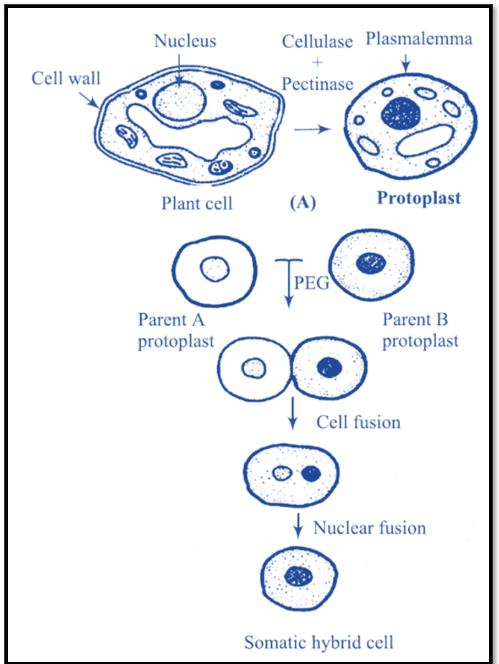
Tissue Culture
- It simply means culturing tissue in nutritional media, in vitro.
- Whole plants could be regenerated from explants, i.e., any part of a plant taken out and grown in a test tube, under sterile conditions in special nutrient media.
- Capacity to generate a whole plant from any cell/explant is called totipotency.

- Method of producing thousands of plants through tissue culture is called micro-propagation
- Each of these plants will be genetically identical to the original plant from which they were grown, i.e., they are somaclones.
- If the plant is infected with a virus, the meristem (apical and axillary) is free of virus. Hence, we can remove the meristem and grow it in vitro to obtain virus-free plants.

- Isolated protoplasts (after digesting their cell walls) from two different varieties of plants – each having a desirable character – can be fused to get hybrid protoplasts, which can be further grown to form a new plant. These hybrids are called somatic hybrids while the process is called somatic hybridisation. Eg : Pomato

Fig : Pomato
Summary
- Animal husbandry is the practice of taking care and breeding domestic animals by applying scientific principles. The ever-increasing demand of food from animals and animal products both in terms of quality and quantity has been met by good animal husbandry practices. These practices include (i) management of farm and farm animals, and (ii) animal breeding. In view of the high nutritive value of honey and its medicinal importance, there has been a remarkable growth in the practice of bee-keeping or apiculture. Fishery is another flourishing industry meeting the ever-increasing demand for fish, fish products and other aquatic foods.
Plant breeding may be used to create varieties, which are resistant to pathogens and to insect pests. This increases the yield of the food. This method has also been used to increase the protein content of the plant foods and thereby enhance the quality of food. In India, several varieties of different crop plants have been produced. All these measures enhance the production of food. Techniques of tissue culture and somatic hybridisation offer vast potential for manipulation of plants in vitro to produce new varieties.
